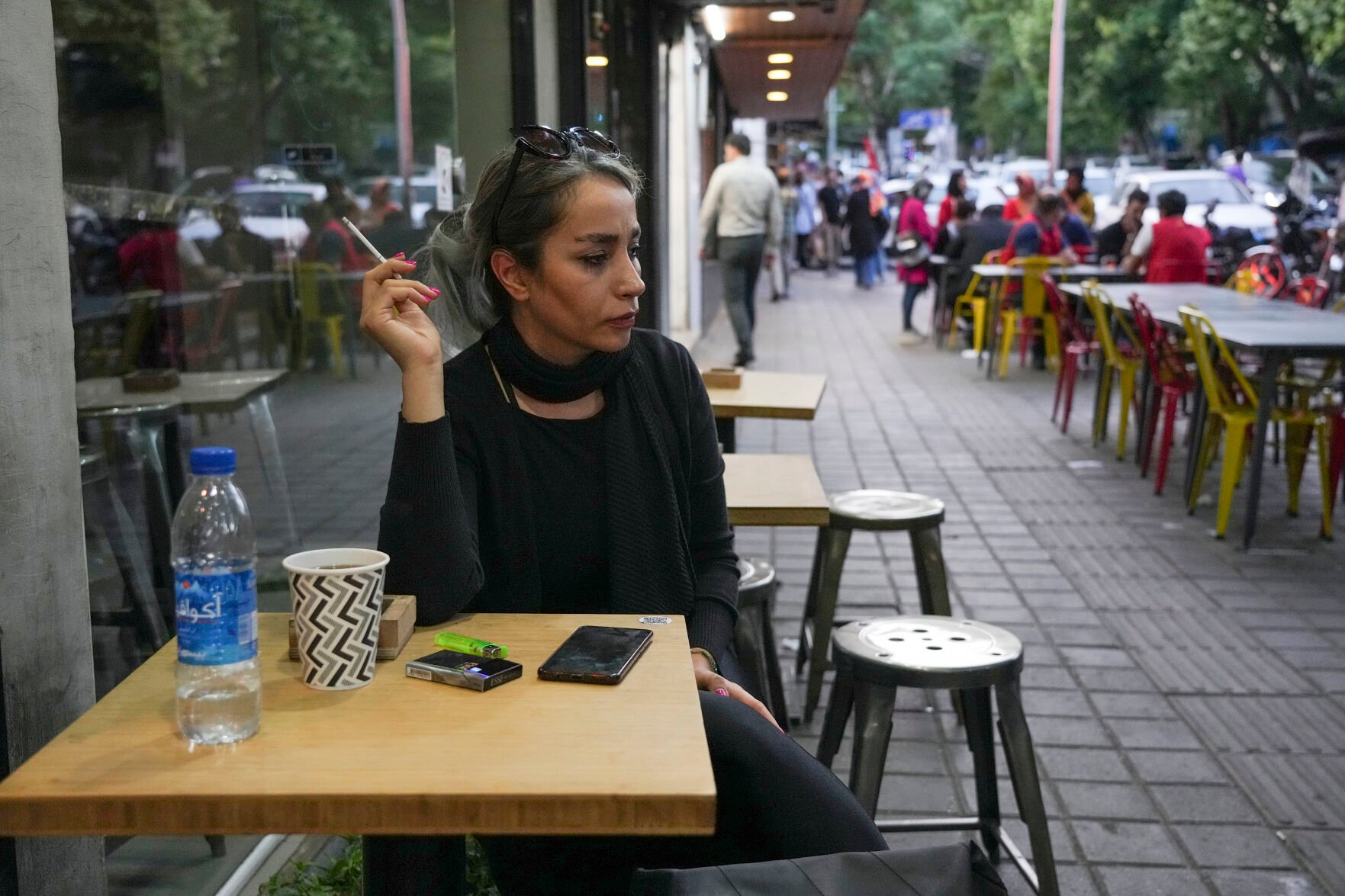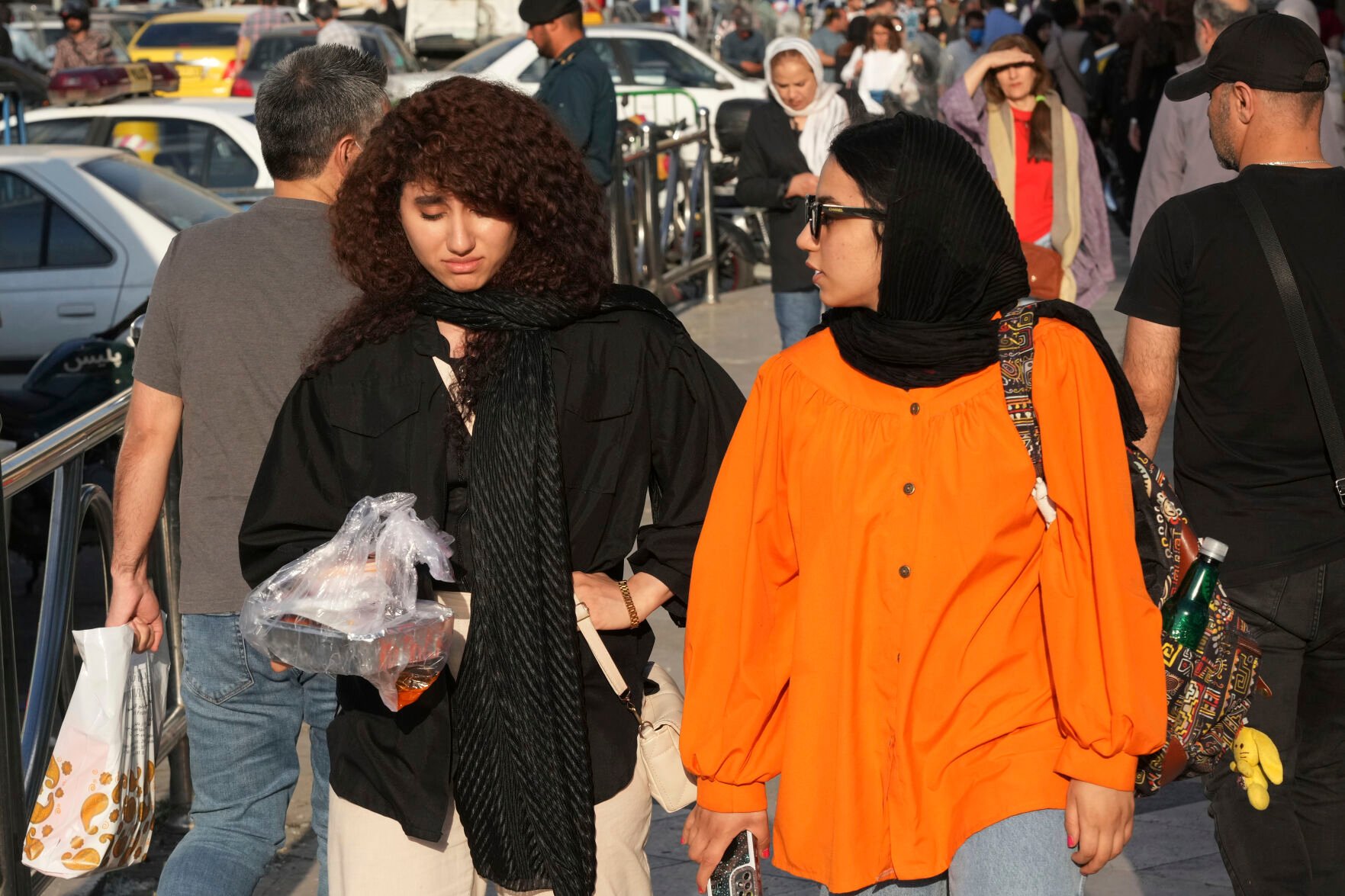TEHRAN, Iran — Billboards across Iran’s capital proclaim that women should wear their mandatory headscarves to honor their mothers. But perhaps for the first time since the chaotic days following Iran’s 1979 Islamic Revolution, more women — both young and old — choose not to do so.
Such open defiance comes after months of protests over the September death of 22-year-old Mahsa Amini in the custody of the country’s morality police, for wearing her hijab too loosely. While the demonstrations appear to have cooled, the choice by some women not to cover their hair in public poses a new challenge to the country’s theocracy. The women’s pushback also lays bare schisms in Iran that had been veiled for decades.

Vahid Salemi, Associated Press
A woman sits in the alfresco dining area of a cafe at Tajrish commercial district without wearing her mandatory Islamic headscarf April 29 in northern Tehran, Iran.
Authorities have made legal threats and closed down some businesses serving women not wearing the hijab. Police and volunteers issue verbal warnings in subways, airports and other public places. Text messages have targeted drivers who had women without head covering in their vehicles.
However, analysts in Iran warn that the government could reignite dissent if it pushes too hard. The protests erupted at a difficult time for the Islamic Republic, currently struggling with economic woes brought on by its standoff with the West over its rapidly advancing nuclear program.
Some women said they’ve had enough — no matter the consequence. They say they are fighting for more freedom in Iran and a better future for their daughters.
Some suggested the growing numbers of women joining their ranks might make it harder for the authorities to push back.
“Do they want to close down all businesses?” said Shervin, a 23-year-old student whose short, choppy hair swayed in the wind on a recent day in Tehran. “If I go to a police station, will they shut it down, too?”
Still, they worry about risk. The women interviewed provided only their first names, for fear of repercussions.
Vida, 29, said a decision by her and two of her friends to no longer cover their hair in public is about more than headscarves.
“This is a message for the government, leave us alone,” she said.
Iran and neighboring Taliban-controlled Afghanistan are the only countries where the hijab remains mandatory for women. Before protests erupted in September, it was rare to see women without headscarves, though some occasionally let their hijab fall to their shoulders. Today, it’s routine in some areas of Tehran to see women without headscarves.
For observant Muslim women, the head covering is a sign of piety before God and modesty in front of men outside their families. In Iran, the hijab — and the all-encompassing black chador worn by some — has long been a political symbol as well.
Iran’s ruler Reza Shah Pahlavi in 1936 banned the hijab as part of his efforts to mirror the West. The ban ended five years later when his son, Shah Mohammad Reza Pahlavi, took over. Still, many middle and upper-class Iranian women chose not to wear the hijab.

Vahid Salemi, Associated Press
A woman walks around Tajrish commercial district without wearing her mandatory Islamic headscarf April 29 in northern Tehran, Iran.
By the 1979 Islamic Revolution, some of the women who helped overthrow the shah embraced the chador, a cloak that covers the body from head to toe, except for the face. Images of armed women encompassed in black cloth became a familiar sight for Americans during the U.S. Embassy takeover and hostage crisis later that year. But other women protested a decision by Grand Ayatollah Ruhollah Khomeini ordering the hijab to be worn in public. In 1983, it became the law, enforced with penalties including fines and two months in prison.
Forty years later, women in central and northern Tehran can be seen daily without headscarves. While at first Iran’s government avoided a direct confrontation over the issue, it has increasingly flexed the powers of the state in recent weeks in an attempt to curb the practice.
In early April, Iran’s Supreme Leader Ayatollah Ali Khamenei declared that “removing hijab is not Islamically or politically permissible.”
Khamenei claimed women refusing to wear the hijab are being manipulated. “They are unaware of who is behind this policy of removing and fighting hijab,” Khamenei said. “The enemy’s spies and the enemy’s spy agencies are pursuing this matter. If they know about this, they will definitely not take part in this.”
Hard-line media began publishing details of “immoral” situations in shopping malls, showing women without the hijab. On April 25, authorities closed the 23-story Opal shopping mall in northern Tehran for several days after women with their hair showing were seen spending time together with men in a bowling alley.
“It is a collective punishment,” said Nodding Kasra, a 32-year-old salesman at a clothing shop in the mall. “They closed a mall with hundreds of workers over some customers’ hair?”
Police have shut down over 2,000 businesses across the country over admitting women not wearing the hijab, including shops, restaurants and even pharmacies, according to the reformist newspaper Shargh.
“This is a lose-lose game for businesses. If they warn (women) about not wearing the hijab as per the authorities’ orders, people will boycott them,” said Mohsen Jalalpour, a former deputy head of Iran’s Chamber of Commerce. “If they refuse to comply, the government will close them down.”
-
As more women forgo the hijab, Iran’s government pushes back
From TripAdvisor: Also known as Isfahan Royal Square, a huge open area built in the 17th century is adorned by impressive mosques, fountains and bazaar.
From TripAdvisor: Also known as Isfahan Royal Square, a huge open area built in the 17th century is adorned by impressive mosques, fountains and bazaar.
-
As more women forgo the hijab, Iran’s government pushes back
From Fars Travel Company, which offers tours of the site: "Inscribed on UNESCO World Heritage list in 2009 as a ‘masterpiece of creative genius’, the Shushtar Historical Hydraulic System in southwest Iran is a destination for history buffs, nature lovers and travelers who eyewitness how the prehistoric yet homogeneous hydraulic system works."
From Fars Travel Company, which offers tours of the site: "Inscribed on UNESCO World Heritage list in 2009 as a ‘masterpiece of creative genius’, the Shushtar Historical Hydraulic System in southwest Iran is a destination for history buffs, nature lovers and travelers who eyewitness how the prehistoric yet homogeneous hydraulic system works."
-
-
As more women forgo the hijab, Iran’s government pushes back
AP Photo/Hasan Sarbakhshian
Muslim Pilgrims visit the mausoleum of Imam Reza, the 8th Shiite Muslim's Imam and grandson of the Prophet Mohammad in Mashhad, 900 km (540 miles) in northeastern of Tehran, Iran Monday, Aug. 11, 2008. Today the holy shrine and its museum hold one of the most extensive cultural and artistic treasuries of Iran, in particular manuscript books and paintings. Several important theological schools are associated with the shrine of the Eighth Imam. There are also over 20 million pilgrims who visit the shrine every year.
AP Photo/Hasan Sarbakhshian
Muslim Pilgrims visit the mausoleum of Imam Reza, the 8th Shiite Muslim's Imam and grandson of the Prophet Mohammad in Mashhad, 900 km (540 miles) in northeastern of Tehran, Iran Monday, Aug. 11, 2008. Today the holy shrine and its museum hold one of the most extensive cultural and artistic treasuries of Iran, in particular manuscript books and paintings. Several important theological schools are associated with the shrine of the Eighth Imam. There are also over 20 million pilgrims who visit the shrine every year.
-
As more women forgo the hijab, Iran’s government pushes back
From the Tabatabaei House website: "The Tabatabaei house is the bride of the houses of Iran. Its flawless architecture and superbly beautiful appearance have brought it a reputation for it. The Tabatabaei House as a Tourist Attraction is one of the most valuable houses in Iran, which can be seen in that the elements of Iranian architecture and is a masterpiece of Kashan's architecture."
From the Tabatabaei House website: "The Tabatabaei house is the bride of the houses of Iran. Its flawless architecture and superbly beautiful appearance have brought it a reputation for it. The Tabatabaei House as a Tourist Attraction is one of the most valuable houses in Iran, which can be seen in that the elements of Iranian architecture and is a masterpiece of Kashan's architecture."
-
-
As more women forgo the hijab, Iran’s government pushes back
The Jameh mosque was built in the 12th century mosque. The entrance, shown here on right, is decorated entirely in tile work.
The Jameh mosque was built in the 12th century mosque. The entrance, shown here on right, is decorated entirely in tile work.
-
As more women forgo the hijab, Iran’s government pushes back
The Qavam House was built in the late 1800s for the Qavam family. Today it's a museum and is open to the public.
It's also known as Narenjestan e Ghavam.
The Qavam House was built in the late 1800s for the Qavam family. Today it's a museum and is open to the public.
It's also known as Narenjestan e Ghavam.
-
-
As more women forgo the hijab, Iran’s government pushes back
From Fars Travel Company: "Bazaar-E-Vakil of Shiraz is one of the most famous historical and traditional bazaars of Iran. This bazaar had been built with the order of Karim Khan Zand (Iranian King) at about 200 years ago. (It is thought that the market originally was established by the Buwayhids in the 11th century AD, and was completed mainly by the Atabaks of Fars, and only was renamed after Karim Khan Zand in the 18th century.)"
From Fars Travel Company: "Bazaar-E-Vakil of Shiraz is one of the most famous historical and traditional bazaars of Iran. This bazaar had been built with the order of Karim Khan Zand (Iranian King) at about 200 years ago. (It is thought that the market originally was established by the Buwayhids in the 11th century AD, and was completed mainly by the Atabaks of Fars, and only was renamed after Karim Khan Zand in the 18th century.)"
-
As more women forgo the hijab, Iran’s government pushes back
The historic Persian garden is a World Heritage Site and protected by Iran's Cultural Heritage Organization. It's open to the public as part of the Shiraz Botanical Garden.
The historic Persian garden is a World Heritage Site and protected by Iran's Cultural Heritage Organization. It's open to the public as part of the Shiraz Botanical Garden.
-
-
As more women forgo the hijab, Iran’s government pushes back
From IranReview.org: "The name, 'Forty Columns,' was inspired by the twenty slender wooden columns supporting the entrance pavilion, which, when reflected in the waters of the fountain, are said to appear to be forty."
From IranReview.org: "The name, 'Forty Columns,' was inspired by the twenty slender wooden columns supporting the entrance pavilion, which, when reflected in the waters of the fountain, are said to appear to be forty."
-
As more women forgo the hijab, Iran’s government pushes back
Kandovan is an ancient city built into the side of foothills near Mount Sahand. About 600 people still live there.
It's similar to the more well known cliff city of Cappadocia in Turkey.
Kandovan is an ancient city built into the side of foothills near Mount Sahand. About 600 people still live there.
It's similar to the more well known cliff city of Cappadocia in Turkey.


